
Diving the Cenotes of Mexico
A journey into the past
Cenote comes from the Mayan word D’zonot which refers to a place of water access.
The Yucatan peninsula is the top location in the world to dive caverns and caves, having the world’s largest underwater cave system which extends for more than 368.6 km. Nestled within the jungle there are over 7000 cenotes.
Come with us to explore these natural wonders. With crystal clear waters, dense jungle, magnificent rock formations and mesmerizing haloclines.
CAVERN OR CAVE
For most of you, we will enter what is called the cavern zone. The mystical place where the darkness and light meet joining the two worlds of the open water and the underground cave system. Whereas those who are trained in cave diving can dive fully into the darkness.
CAVERN
The term cavern zones means we will always be within 60m/200ft of an exit, though it may not be the one we entered by: it could be another cenote we passed by or an underground air dome. We will also always be able to see the natural light from the entrance and swim along a permanent guideline, as an extra assurance that we can easily find our way back to the surface.
CAVE
Cave diving goes past the point of being able to see the natural light and enters into the darkness beyond. This form of diving requires specialized training and equipment to safely navigate the maze underneath the jungle floor.
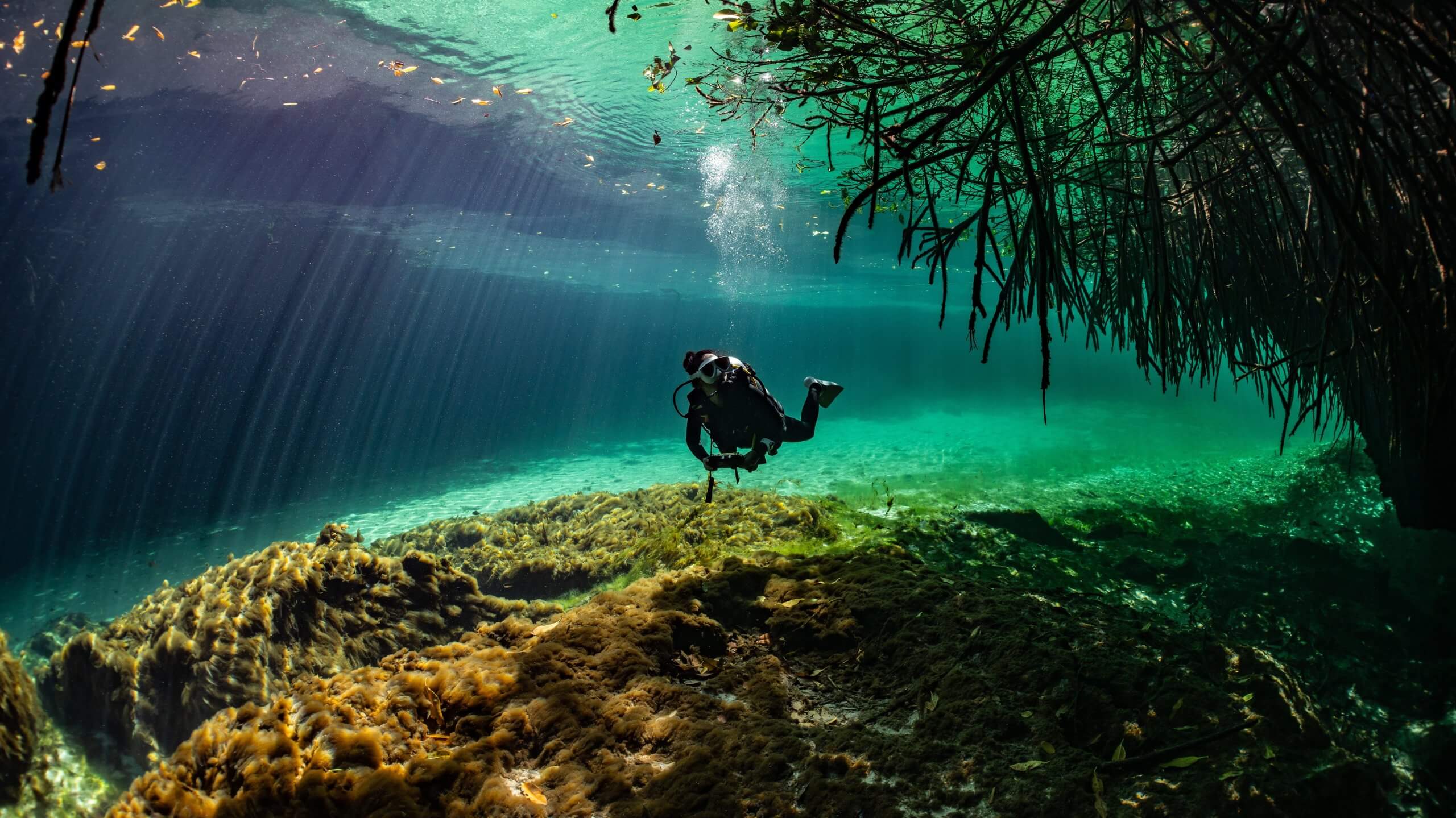
WHAT CERTIFICATION DO I NEED?
To explore the cavern zone an Open Water certification is the minimum requirement. However some deeper cenotes require an Advanced certification.
We will be heading into an overhead environment with four fragile walls to avoid rather than just the reef below, so buoyancy can be a challenge. We therefore require that you have dove within the last 6 months for your own safety and the preservation of the cave. If it’s been a while for you don’t worry, we can always hop into the ocean for a quick warm up.
We also offer cave diving courses and guided dives, if you are ready to search further.
WHAT IS THERE TO SEE?
SPELEOTHEMS – SPECTACULAR ROCK FORMATIONS
Better known as stalagmites and stalactites, speleothems form as rainwater seeps through cracks in the cave ceiling. As the water passes through the rock it picks up small particles of sediment, leaving behind a tiny deposit as it drips off the cave roof and also a deposit on the floor below. This slowly forms into a stalagmite above and stalactite below, which will eventually form a pillar as they grow towards each other.
These formations only grow about 0.4 inches every 1000 years, showing the immense history stored in these rocks and cave systems shaped by water. (Visit our history of cenotes page) The floor also shows the history of the water’s path in the ripples of a long ago riverbed or the ridges of calcified rock pools.
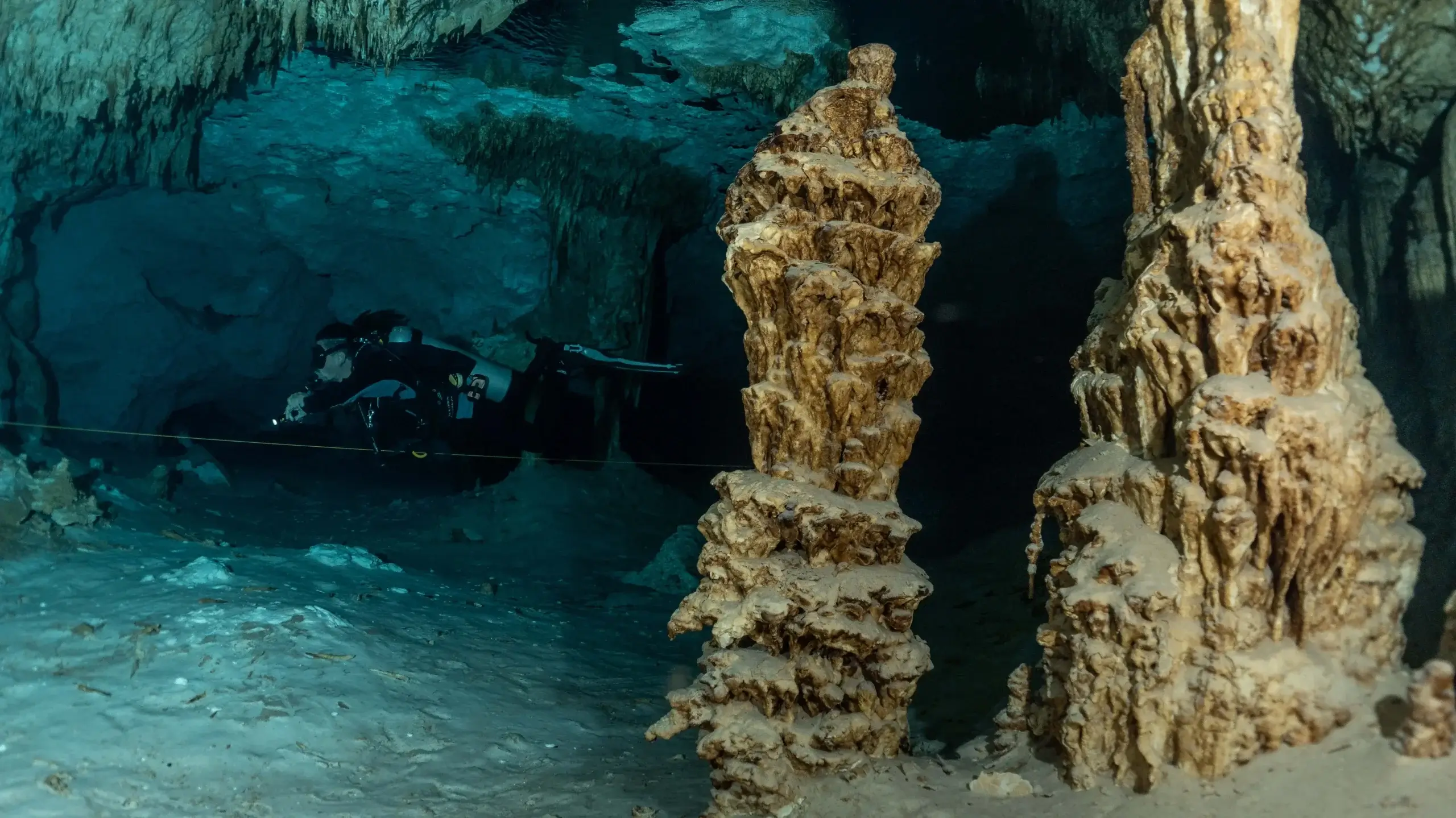
Amazing and spectacular decorations await you inside, covering many of the floors and ceilings. There are stunning pillars some the width of massive tree trucks, others small and dainty. Stalagmites and stalactites are suspended indefinitely in the water, some nearly having reached their partner only millimeters or centimeters apart, maybe one day to meet again when the water levels sinks and the cave is once more dry.
Some caves have ceilings covered in tiny decorative stalactites, like a massive chandelier or walls which look like solidified waterfalls. Some parts of the cenotes which are still dry are carrying on this slow process of new rock formations.
A fun way to remember which is which, is the rhyme: Stalactites hold tight to the ceiling and Stalagmites might one day reach the ceiling.
FOSSILS
See the fossilized skeletons of million year old corals, huge conch shells and other amazing shells embedded in the rock of a long ago reef. Dive over beautiful rippled floors of once flowing river beds forever trapped in time.
You may even glimpse some bones of animals once trapped by the steep cenote walls or Mayan pottery left as offerings to the gods.
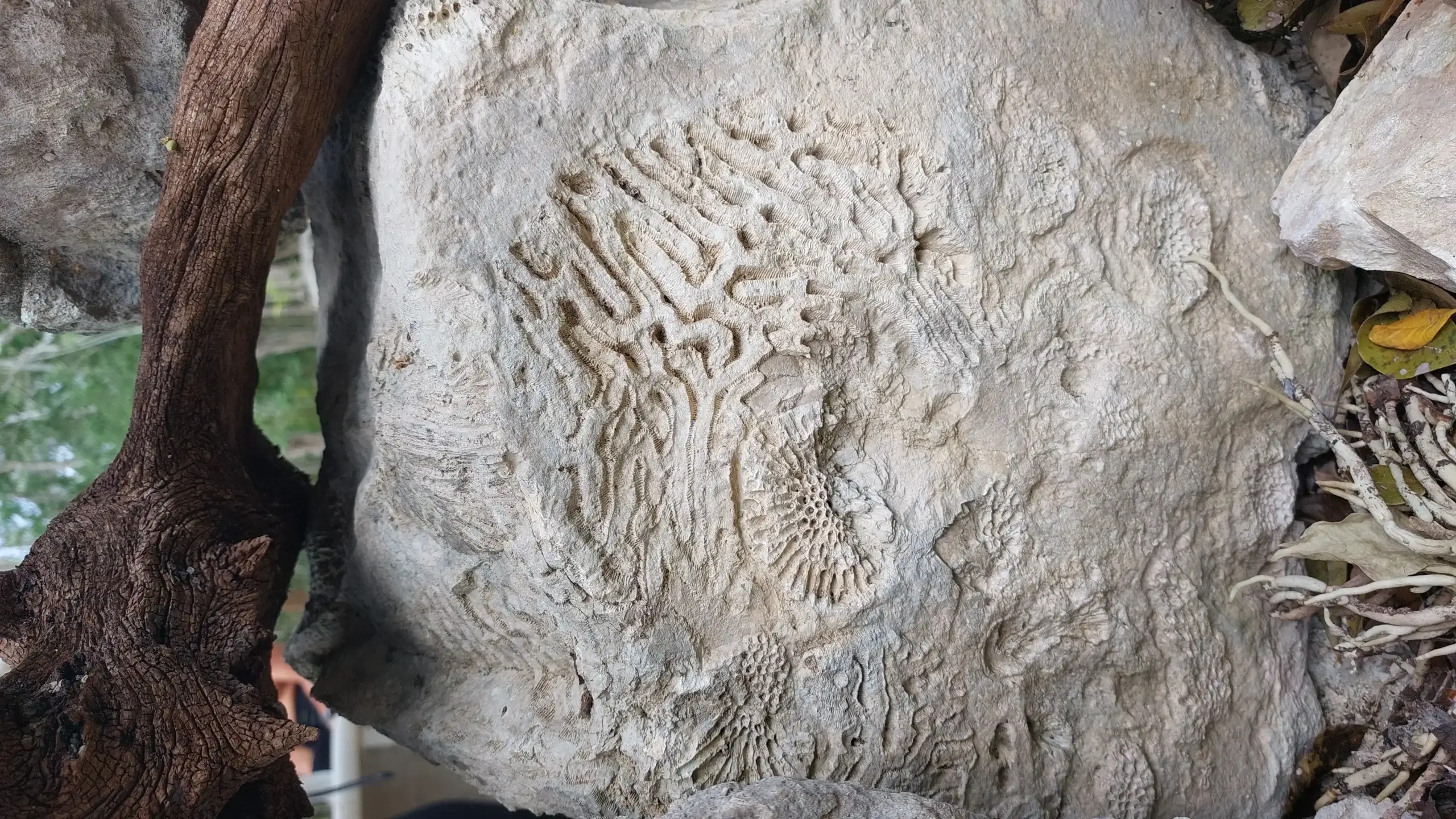
THE HALOCLINE PHENOMENON
These flooded cave systems that connect cenotes are underground rivers taking the rainwater out to sea. However many are located below sea level, meaning that salt water has also entered in.
These two types of water stay separate from one another because of their differences in density and temperature, the heavy warm salt water on the bottom and the lighter cool fresh water on the top. The place where the waters meet is called the halocline.
The stunning visual effects made by the two waters needs to be seen to be fully understood. At times the water layers appear as a shimmering ripple giving the effect of flying over a second river in the water below.
Moving between these layers feels like a movie flashback as the scene blurs and blends before your eyes. The waters do not readily mix and as you disturb them your vision is distorted, though if you turn your head slightly out of the area that was disturbed all is crystal clear again. You can even move slowly up and down watching the layer move past your eyes. The depth at which the fresh water turns to salt depends on the sea level relevant to its distance from the ocean.
In Cenote Eden the temperature change as you move through the halocline can be very distinct, up to three degrees Celsius warmer as you enter the salt water!
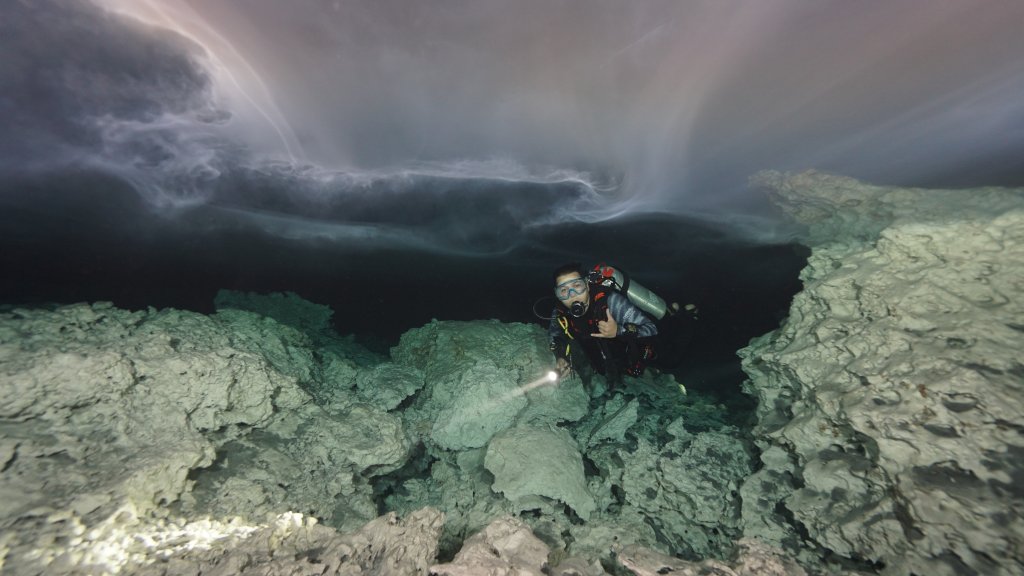
MYSTERIOUS SULPHUR CLOUDS
As a result of bacteria decomposing leaves and branches that have fallen into the cenote, hydrogen sulfide is produced. This gas dissolved in the water creates a smokey cloud or mist held in place by the depth or change in water type. It can create a thick looking cloud as in Cenote Angelita obscuring all light from above if you descend through it or fantastic swirling smoke trails through the water.
See fallen logs protruding eerily from the mist and watch it swirl as you pass through. Sometimes you can even smell the Sulphur, though don’t linger too long as this gas is corrosive.
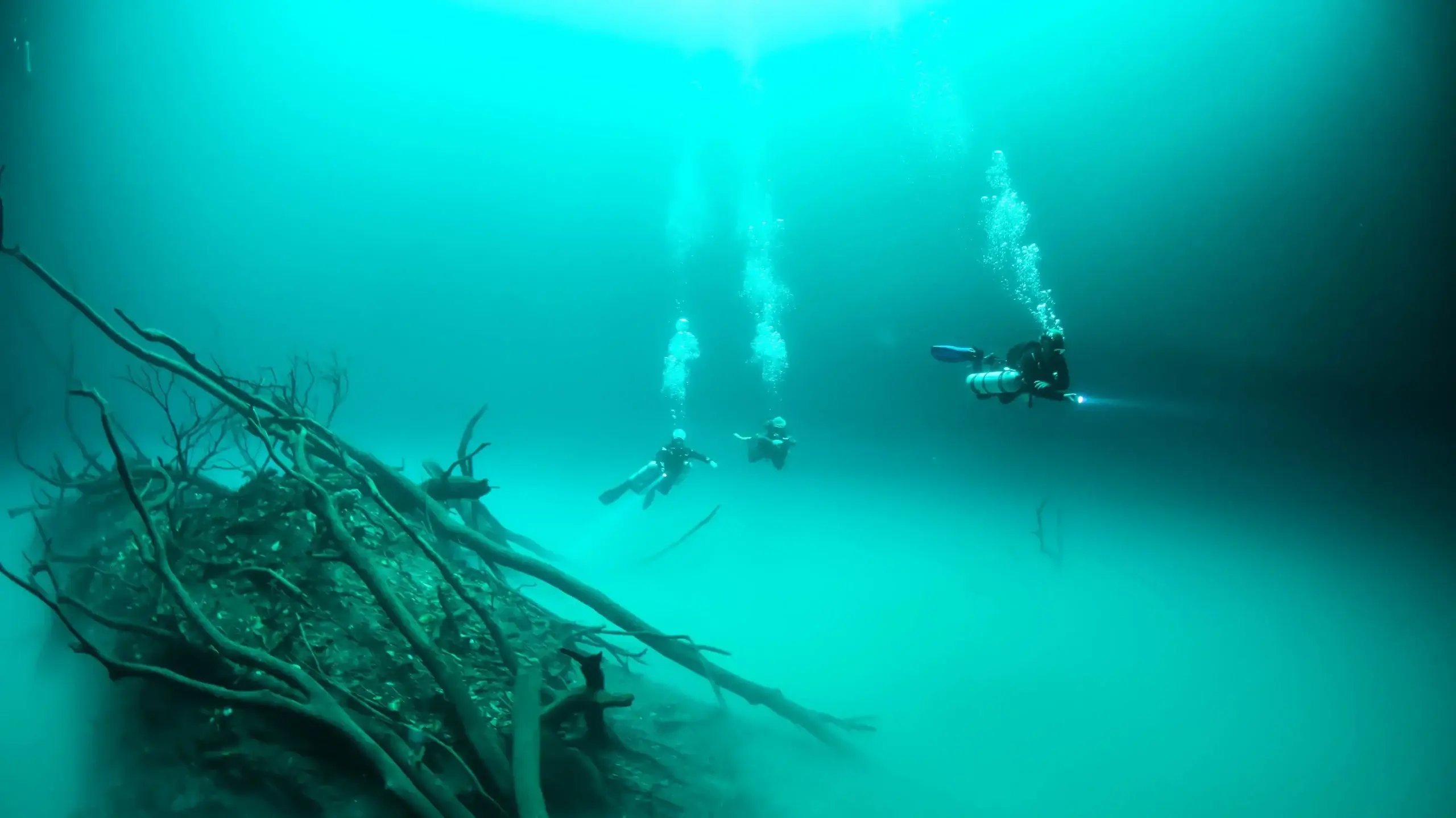
AWE INSPIRING LIGHT BEAMS
Depending on the size of the cenote entrance, you can experience many different captivating lights entering the water. From the “Mexican northern lights” in Cenote Eden, and Cenote Kulukan; dancing beams splitting off into rainbows or the one huge penetrating beam into the depths of The Pit.
Even the smaller or more sheltered entrances like that in Cenote Dos Ojos provide eerier green or vivid blue light backdrops to silhouette amazing rock formations.
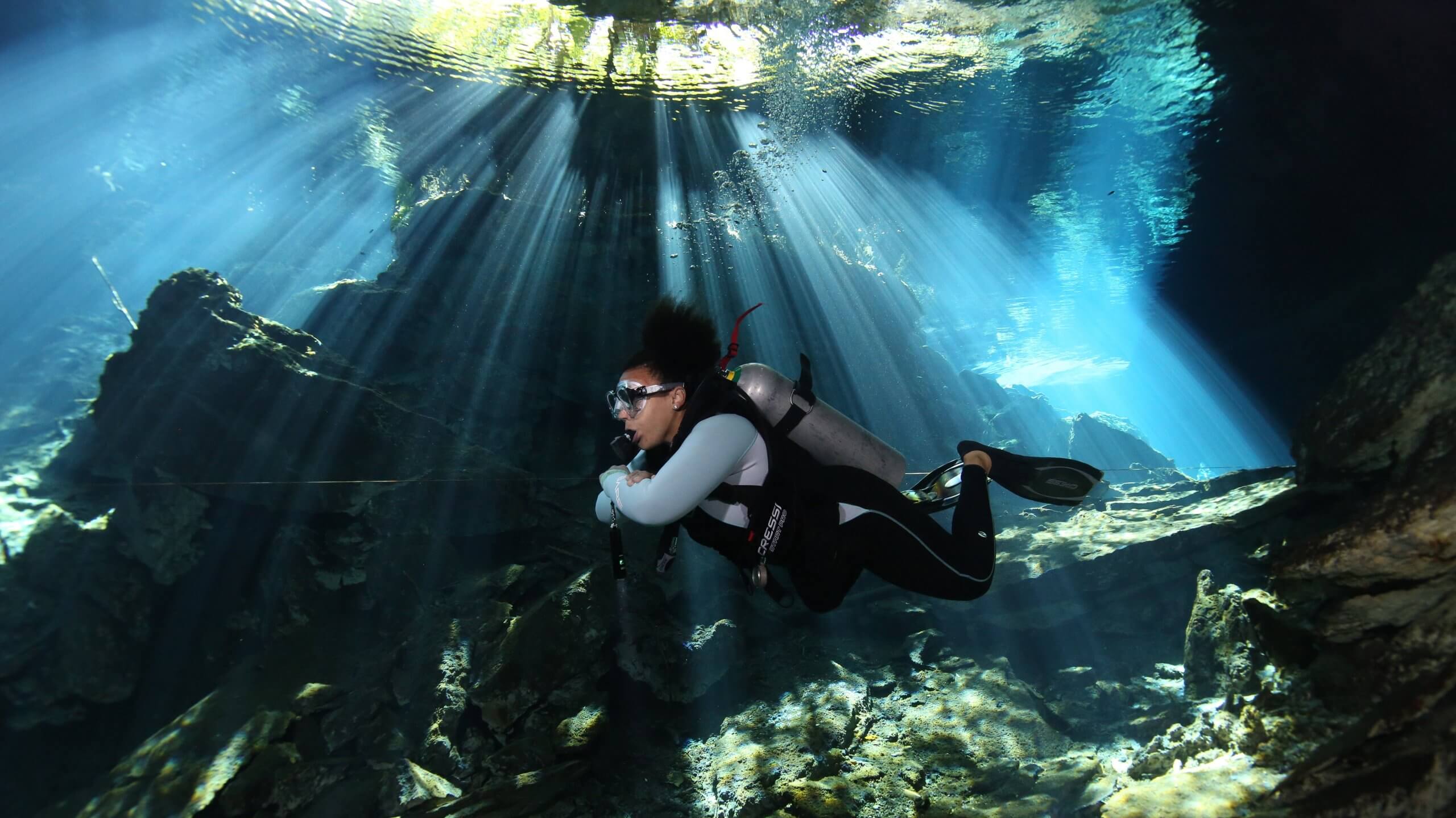
UNDERWATER LIFE
Although connected each cenote’s aquatic life can vary as the path in between is long, winding and dark. Impossible for some fish to cross.
Most of this life stays in the open areas where the sun shines down feeding algae and other small plants on which the fish, crustations and turtles can feed. Watch the small bubbles of oxygen float up as the plants breathe. Cenote Carwash has some amazing water lilies.
Witness Mollies perform flamboyant mating dances in Cenote Eden, shiny Ciclids swimming in Cenote Kulukan and curious catfish which can survive the long underwater journey from cenote to cenote. Mesoamerican turtles can be seen sunning themselves on quiet mornings and even a few cenotes like Casa Cenote are home to a Mexican crocodile.
As you dive into the darker areas there is less life because of the lack of food though still life survives. Deep cave dwelling creatures can occasionally be seen, such as pure white shrimp and the fascinating blind fish with its concaved eyeless sockets.
JUNGLE LIFE ABOVE THE WATER
There is also a fascinating array of life on land in the surrounding jungle, massive Iguana sunning themselves, swallows nesting in rock crevasses, bats sleeping in dark corners and the famous Motmot bird with its distinct colors and pendulum like tail.
You will also see trees growing through small cracks in the rock right into the water below.
PRESERVATION AND CONSERVATION
Cenotes house millions of years of history, ancient reefs, ice ages and remains of past cultures. They are a fragile and delicate ecosystem that requires our preservation and conservation. Divers must respect the environment, follow responsible diving practices and avoid touching or disturbing the natural formations and fossils.

We have cavern rules in place to protect these cenotes such as no knives, no gloves, no snorkels, no trailing equipment, no touching (it is a federal offence) and no drawing on the rock or sediment.
As the only freshwater source to the whole of the peninsular we also don’t allow the use of any kind of creams, sprays or protectors on your skin that could contaminate the environment (even the so called “eco-friendly” products).
By preserving the cenote’s pristine beauty, future generations of divers can continue to appreciate its wonders.
DIVERS SAFETY
Cenote diving is completely different to anything you will have experienced before, stunningly beautiful but with its own unique set of challenges and so your safety is of the utmost importance to us.

There are some important safety guidelines we follow for you to keep in mind.
ALWAYS STAY WITH YOUR GUIDE
In Mexico it is mandatory that you have a guide that is both a scuba instructor and full cave qualified. Your guide will help you navigate these complex caverns, ensuring you see all the highlights on a safe and enjoyable dive.
THE RULE OF THIRDS
In cavern and cave we follow this rule to ensure there is enough air for any unexpected situations. We enter with a full tank and start to make our way out once we used one third of our air, leaving one third as a reserve.
STAY WITHIN YOUR LIMITS
Cenote diving can be challenging so it is important to stay within the limits of your training and your own personal comfort. We will always take you to cenotes within your skill level and gradually work our way up to more challenging dives. Remember anyone has the right to cancel a dive at any time no questions asked.
BE FAMILIAR WITH YOUR EQUIPMENT
As most divers rent equipment make sure you know where everything is and it is in good working condition. We will also be using torches which your guide will teach you some new signals using them.
BUOYANCY CONTROL
Good buoyancy control ensures a fun and safe dive. It conserves your air supply and the delicate underwater environment around you. This can be challenging in cenotes as there are a lot of ups and downs swimming through the passages, it can really test and improve your skills.
TRIM AND KICKS
Your trim is the position in which you lie in the water. If you dive in a flat position your buoyancy will be easier and you will avoid kicking up any silt. Now is a good time to learn to use your shoulder and back dumps to avoid any turning when releasing air from your BCD. The frock kick is also a good technique to avoid disturbing the floor and will help to improve your buoyancy.
CAMERAS
The use of cameras is allowed in most cenotes, though there may be an entrance fee. However, for your very first cenote dive we do not allow the use of cameras, entering a whole new challenging environment and getting accustomed to the new way of diving is challenging enough.
Cameras can be distracting and your safety and cave preservation come first, so you must maintain good buoyancy and awareness when using one.


